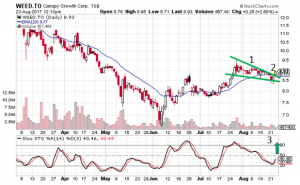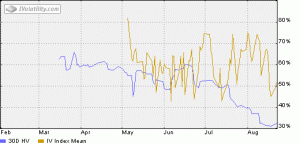Embracing Volatility on a Canadian Disruptor

Fewer topics have been more hotly debated in political (and social) circles then the legalization of marijuana. Now despite which direction your moral compass points on this, it’s an industry that is here to stay. In an economic environment where governments continue to look for new ways to get into our pockets, it is no surprise that we are heading down this road. According to the Colorado Department of Revenue 2016 Annual Report , the state pulled in over $150 million in tax revenue on approximately $1.3 billion in marijuana revenue and the projections are for continued growth. Just imagine these numbers if applied across Canada under the same legal framework. Sufficed to say, there is a compelling incentive for the Canadian government to broaden their acceptance of the “weed” beyond medical to recreational as well.
The Canadian Medical marijuana industry continues to blossom. At the beginning of 2017, Canopy Growth Corporation (TSX:WEED) announced the acquisition of Mettrum for a reported $430 million. This industry is clearly in its formative stages but WEED is focused on establishing itself as a force to be reckoned with. Of notable interest, with fragmented legalization of this industry in the U.S., many foreign investors are paying close attention to what’s happening here. A federal ruling legalizing the production and sale of marijuana across all provinces will make Canada a much more attractive place to establish subsequently and grow a business.
With all this in mind, the Options Brief for August 7th found right here at optionsmatters.ca prompted me to take a closer look at Canopy Growth Corporation (TSX:WEED). Options on WEED began trading back in May and the open interest is compelling. Cleary Canadian investors using options are seeing some sort of opportunity. In which direction is open to individual interpretation however a review of the option chain indicates open interest on calls at 14,462 compared to 5,978 for puts at present (August 23, 2017).
As a technical analyst, I was compelled to look at the price chart (courtesy of StockCharts.com) and was pleased to see several technical signals that indicated a potential bullish opportunity.
- Declining Wedge – Bullish technical pattern
- Break above the 20 bar Exponential Moving Average
- Stochastic Momentum Indicator oversold and gaining upside momentum
With that in mind, it is important to consider that “disruptors” such as TSX:WEED often trade with very high valuations priced in. Investors are prepared to pay for potential value, bidding the price higher without regard to current valuations. This typically results in some volatile price action and expensive options as the market prices in risk and uncertainty.
This volatility can be visualized by comparing the stocks 30 day historic volatility (blue) with the options average implied volatility of the options (gold). In the chart below (courtesy of IVolatility.com), we can see that HV is 30% while IV is 50%. The market is pricing in a significant move.

As an option trader, we have a few ways to take advantage of this. The approach is predicated by what you are looking to accomplish.
My immediate consideration is the high implied volatility. This suggests that option contracts are expensive to purchase outright. From this observation, we can either use a spread strategy to help offset the cost (to be addressed another day), or implement an option writing strategy to take advantage of the high implied volatility as a seller.
Option Writing Strategy 1 – Put Write
If you are interested in owning the shares outside of your registered account, you can sell a put. By selling a put option you are paid a premium to assume the obligation of taking possession of the shares at the strike price sold.
For example, with the shares of TSX:WEED trading at $8.81 on August 24, an October 8.00 strike put is bidding $0.70. The put writer is being paid $0.70/share to take on the obligation of purchasing the stock at $8.00 over the next 56 days. If we want to own the stock (100 shares for every put written), our average cost if the shares pull back and we are assigned to buy them at $8.00 is $7.30. If the shares are trading above $8.00 on October 19th, the put expires worthless and we keep the premium. This is a whopping, 8.75% return in less than 2 months. Why so much? Remember, we are getting paid to assume the risk and uncertainty on the shares. With that in mind, if we want to own the company, this is a great way to generate cashflow and get paid to wait for the stock to pull back to a more favorable price.
Option Writing Strategy 2 – Covered Call
If we want to add a position to our registered account and are comfortable owning the shares outright, we could apply the Covered Call strategy.
In this scenario, we would sell 1 call option against every 100 shares you purchase. Once again, with the shares trading at $8.81, we can sell and October call at the $10.00 strike and collect $0.30. We are being paid $0.30/per share for the obligation of delivering the shares at $10.00 over the next 56 days.
Buy selling the call option and collecting $0.30 we have effectively lowered our cost base to $8.51. If the shares stay the same, we generate a 3.52% return as the options expire in less than 2 months. We can then continue to sell calls against the shares to generate cash flow.
If the shares hit $10.00, we are assigned to deliver the shares at the strike and get to keep the $0.30 premium. This equates to a 17.5% return in less than 2 months.
The Risks
For both the put writer in strategy 1 and the call writer in strategy 2, the risk is in the underlying shares. In both cases we would incur a loss (realized if we sell the shares) if WEED dropped in value. With that in mind, we will have mitigated that loss through the collection of a healthy option premium.
Combining the Two
For the more active investor, combining the two strategies becomes a great way to generate cash flow from a stock with expensive options. The approach involves selling an at-the-money, short term put and continuing to do so until assigned to purchase the shares. Once we own the shares, we sell an-at-the money, short term call. If assigned to sell the shares at the written strike, we re-enter the position by selling the put again…and so. Depending on the account size, this can be somewhat commission intensive. In addition, this approach is only permissible in non-registered, margin accounts.
Regardless of your feelings on the underlying industry, options on Canopy Growth Corp (TSX:WEED) are being actively traded with significant implied volatility priced in to the contract premiums. These are very attractive characteristics to an option writer and certainly worth taking a closer look at.
CEO and Director of Business Development
R.N. Croft Financial Group
Jason is CEO and Director of Business Development at R N Croft Financial Group, a member of the Croft Investment Review Committee and a Derivative Market Specialist by designation. In addition, he is an educational consultant for Learn-To-Trade.com and an instructor for the TMX Montreal Exchange.
The information provided on this website, including financial and economic data, quotes and any analysis or interpretation thereof, is provided solely for information purposes and shall not be construed in any jurisdiction as providing any advice or recommendation with respect to the purchase or sale of any derivative instrument, underlying security or any other financial instrument or as providing legal, accounting, tax, financial or investment advice. Bourse de Montréal Inc. recommends that you consult your own advisors in accordance with your needs before making decision to take into account your particular investment objectives, financial situation and individual needs.
All references on this website to specifications, rules and obligations concerning a product are subject to the rules, policies and procedures of Bourse de Montréal Inc. and its clearinghouse, the Canadian Derivatives Clearing Corporation, which prevail over the content of this website. Although care has been taken in the preparation of the documents published on this website, Bourse de Montréal Inc. and/or its affiliates do not guarantee the accuracy or completeness of the information published on this website and reserve the right to amend or review, at any time and without prior notice, the content of these documents. Neither Bourse de Montréal Inc. nor any of its affiliates, directors, officers, employees or agents shall be liable for any damages, losses or costs incurred as a result of any errors or omissions on this website or of the use of or reliance upon any information appearing on this website.
BAX®, CADC®, CGB®, CGF®, CGZ®, LGB®, MX®, OBX®, OGB®, OIS-MX®, ONX®, SCF®, SXA®, SXB®, SXF®, SXH®, SXM®, SXO®, SXY®, and USX® are registered trademarks of the Bourse. OBW™, OBY™, OBZ™, SXK™, SXJ™, SXU™, SXV™, Montréal Exchange and the Montréal Exchange logo are trademarks of the Bourse. All other trademarks used are the property of their respective owners.
© 2024 Bourse de Montréal Inc. All Rights Reserved.
